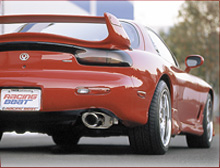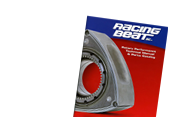Rotary Engine Exhaust Basics

One of best performance upgrades for any RX-7 is a aftermarket exhaust system.
The exhaust system requirements of a rotary engine are notably different from those of a four-stroke reciprocating engine. With rotary engines the exhaust gas temperature is very high - approximately 1,700° -2,000°F at full throttle and high RPM for a 1971-95 peripheral exhaust port engine or about 1600°F for a Renesis (RX-8) side exhaust port engine, as compared to 1,100°-1,400°F for a four-stroke reciprocating engine. Also, the unmuffled exhaust noise of a rotary is very loud!
We have found that these extremely high exhaust gas temperatures require that performance exhaust components be manufactured with tubing of either stainless steel alloy or thick-wall (.120") mild steel. An additional benefit of the use of thick-wall steel tubing is the reduction, in most applications, of exhaust noise transmitted through the tube wall. When selecting exhaust components for a rotary engine application, we strongly suggest that you consider products that were designed specifically for this application. Trust us, we have heard from MANY people over the years that attempted to use cheap, generic mufflers and presilencers, only to have these components fail due the extreme heat and abrasive exhaust pulse of the rotary engine.
Mazda delivered all pre-1981 rotary USA models with thermal reactors to reduce emissions, and the 1981 and later non-turbo models with a cast iron exhaust manifold. Inside, both are similar- basically, a large chamber into which both exhaust ports enter. This "mixing" of the exhaust tends to muffle the noise coming from the engine. Thus, when installing headers for street use, expect some increase in exhaust noise, since the headers tend to keep the exhaust pulses separate. This separation of pulses is largely responsible for the power increase observed when installing headers.
The 1986-92 6-Port non-turbo engines employed steel exhaust port "splitter" sleeves in the rotor housings to both reduce the heat transfer from the exhaust gas to the rotor housing and initially reduce noise by breaking up the exhaust gases as they leave the combustion chambers in advance of entering the cast iron manifold. For street use, these splitters offer no significant reduction in power and can remain in place; however, for racing applications, we recommend that these splitters be removed with a grinding tool while leaving the steel sleeves intact, or you can use the turbo rotor housings - these do not contain exhaust splitter sleeves.
Mazda’s turbocharged engines do not require exhaust splitters because the turbocharger is very effective in reducing exhaust noise, but these engines are equipped with a steel sleeve in the exhaust port to reduce heat transfer from the exhaust gas to the rotor housing water jacket. In our experience there is no significant horsepower benefit gained from removing the sleeve in either street or race applications. Furthermore, retaining the sleeve allows a better match between the rotor housing and the exhaust manifold. If you should hear a rattling noise coming from the engine, usually just off idle, a possible source of this noise is a loose exhaust port sleeve.
Due to the extreme temperatures they must contain, thermal reactors, catalytic converters, and mufflers used on rotary applications occasionally break up internally. Two problems can result: 1) excessive noise and 2) exhaust restriction. In certain 1975 and later models with "reflective" thermal reactors, the restriction problem is especially acute, since the reactors have an internal wall that can collapse. If you should experience a sudden loss of power in your car, though it still starts and idles well, it is very possible that either the thermal reactor or the muffler has collapsed internally. The same is true of the catalytic converter-equipped cars - the catalyst matrix can collapse and restrict exhaust gas flow.
Exhaust Back Pressure Pickup Tube
On the 1986-88 13B 6-Port engines, the auxiliary intake actuators are operated by backpressure from the exhaust system. On the later 1989-92 13B 6-Port engines, these actuators are operated by air pressure from the emissions control air pump. (You may notice a tube extending into the exhaust system on a 1989-92 vehicle, this tube is simply supplying air from the air pump to the catalytic converter to aid in combustion.) When designing or selecting exhaust components for your specific engine application, take this into consideration when selecting a header and/or presilencer.
Emissions
To retain the emission-legal status of your RX-7 or RX-8 you can install only a "cat-back" exhaust system on your vehicle. Exhaust components that are installed behind the catalytic converter(s) can be replaced without impacting the emissions status on that vehicle. (However, sound level restrictions for your state may apply. State governments are continuing to establishing sound level limits for exhaust systems to prevent excessive noise from modified vehicles. Check with you local authorities for more information.) We have addressed many of the most frequently asked questions regarding emissions concerns: RX-7 and RX-8 Emissions FAQ.
Copyright 2007-2024 Racing Beat, Inc ©





